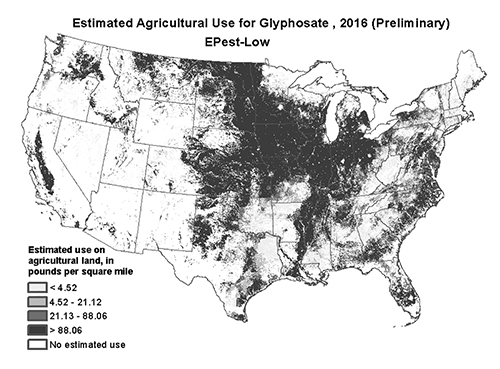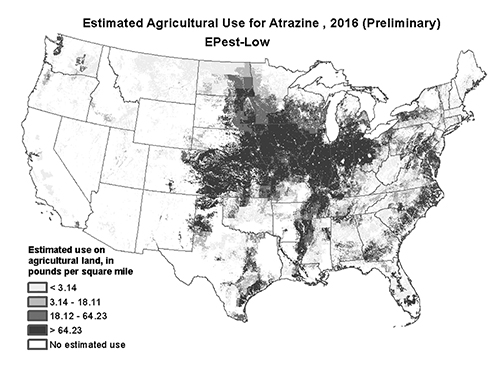
This is the most recent map published by the U.S. Geological Survey showing glyphosate use nationwide. Glyphosate is the main ingredient in Roundup.
The Trump administration continues to lift restrictions on toxic pesticides despite years of research by independent scientists. The fallout in Central Illinois is especially acute. With a location in the middle of the farm belt, Central Illinois is the bull’s eye for environmental exposure to toxic pesticides.
Chlorpyrifos, an insecticide and neurotoxin for children, was slated for removal from the market. That action was blocked by the Trump administration, and the chemical continues to be used in agriculture. The manufacturer of chlorpyrifos gave $1 million to the Trump inauguration committee.
In one documented case just north of Peoria, chlorpyrifos was aerially sprayed by a crop duster and drifted onto an organic farm more than two miles away where three young children lived.
The story with atrazine and glyphosate is the same.
Atrazine was banned in the European Union more than a decade ago because of the dangerous environmental exposures. This is the herbicide that was the focus of a large class action lawsuit settled with an out-of-court agreement calling for $105 million to help water companies remove the toxin from public water supplies, including in Peoria.
In November, the EPA announced it would allow 50% more atrazine in surface waters, a move that will increase the amount that must be removed from public drinking water. Atrazine is an endocrine disrupting chemical linked to birth defects, premature births, cancer, fertility problems and more. It is widely used on corn, soybeans, wheat, golf courses and even Christmas trees.
Some scientists are calling for the United States to follow the EU and issue a total ban on atrazine because of drift. The pesticide gained national attention with the research of Dr. Tyrone Hayes, a scientist at University of California, Berkeley, who has refused to be intimidated by industry advocates. Hayes’ research found severe sexual abnormalities in frogs exposed to atrazine.
Roundup containing glyphosate is the most widely used herbicide in the world. The World Health Organization found glyphosate is a probable human carcinogen. Yet, in April, the Trump EPA issued a statement that glyphosate is safe.
Jennifer Sass, a scientist at the Natural Resources Defense Council, told The Guardian, “Health agencies and credible non-industry experts who have reviewed this question have all found a link between glyphosate and cancer.”

This is the most recent map published by the U.S. Geological Survey showing atrazine use nationwide. Atrazine is used on corn, soybeans, wheat, vegetables, fruit, golf courses, Christmas tree farms and more.

1 comment for “EPA gives OK for more toxic chemical cocktails”